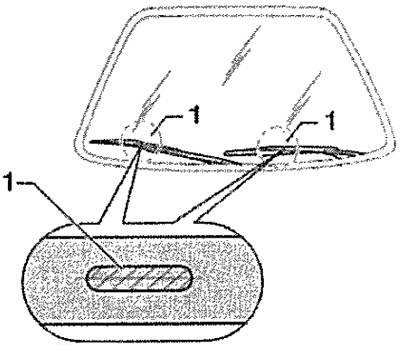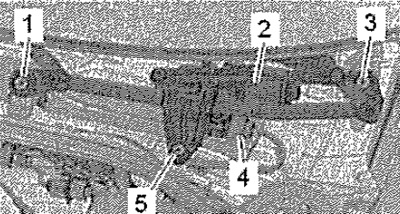Removal and installation of wiper arms with brushes and adjustment of their final position
Note: If the wiper motor needs to be switched on during work, close the hood and switch on the ignition, otherwise the power supply to the wiper motor will be interrupted.
Switch off the ignition and all electrical consumers. Remove protective caps -3- with a screwdriver. Loosen -2- nuts a few turns.

Push puller -T10369/1- onto wiper arm as shown in illustration.
Note: To release the wiper arms, always use the stop -2- to prevent damage to the threads on the wiper motor shaft.
Remove the wiper arm -1- from the shaft by turning the pressure screw -3-. Unscrew the nuts and remove the levers.

Installation
Note: With every second switch-off, the wiper motor moves to an offset end position, in which the wiper blades point in the opposite direction. The wiper motor then runs downwards and then slightly upwards again. This offset end position cannot be used to correct the wiper arms. An end position must be used in which the wiper motor runs in the forward direction and without moving towards the lower end position. If the wiper motor is running in the direction of the displaced end position, the wiping stroke must be switched on again. The offset end position function is activated after 100 wiper cycles from the time of coding, or when a new wiper motor is installed. Whether this function is already activated can be determined by switching the wiper motor on and off again.
Turn the wiper motor on and off and let the levers reach their final position to adjust the wiper arms. Fit the wiper arms with the wipers and align the wiper blades so that they match the marks on the windshield -1-. Lightly tighten the fastening nuts. Switch on the one-time mode and re-check the adjustment of the wiper arms, correct if necessary. Tighten fastening nuts (21 Nm).
Note: The tolerance between the wiper blade and mark -1- is±2 mm.

Removal and installation of the electric motor of screen wipers with the lever mechanism
Switch off the ignition and all electrical consumers. Remove wiper arms with brushes. Remove trim for plenum box. Release screws -1-, -3- and -5-. Remove linkage wiper motor -2- from plenum chamber. Disconnect connector -4-.

Installation
Installation in reverse order. After preliminary positioning of the unit, tighten the screws in the sequence -1-, -2- and -3- first by hand. Then tighten to 8 Nm in the same order.

Removing and installing rain and light sensor -G397-
Carefully! When removing the rain and light sensor -G397- from the retaining plate on the windshield (e.g. windshield replacement), it can be reinstalled. Store the removed sensor in a dust-free room until re-installation and make sure that the silicone connection pad is clean. To facilitate removal, turn the mirror as needed.
Switch off the ignition and all electrical consumers. Remove covers for rain and light sensor -G397-. Unlock catch -1- -arrows-.
Note: After removing the lock, wait at least 1 minute. Thus, the tension in the silicone layer will be removed, and it will not be damaged during removal.

Starting from above, carefully unhook the rain and light sensor -G397- pos. -2- from the holder on the windshield. Unlock and disconnect connector -1-.

Installation
Installation in reverse order.
Carefully! Thoroughly clean the windshield within the retaining plate, e.g. with isopropanol (technical alcohol). Make sure that when installing on the top surface (connection pad) The sensor has not been contaminated or damaged. A sensor with a damaged connection pad must be replaced. There are several sensor options (depending on configuration). When replacing, install the correct part. In case of surface contamination (connection pad) sensor, it can be cleaned by applying and removing the adhesive tape several times.
If a new sensor is being installed, press the catches in -direction of the arrow A- and remove the protective cap -1- in -direction of the arrow B-. Connect connector. Insert the sensor into the holder on the windshield.

Press lock -1- until latches -arrows- close audibly.
Note: Even if installed correctly, there may initially be small air bubbles between the windshield and the connection pad. Approx., after 10 minutes, the contact surface should be free of bubbles. If after 10 minutes the contact surface has not cleared of bubbles, the rain sensor must be removed and reinstalled. Air bubbles between the windshield and the connecting pad lead to malfunctions of the sensor.
When replacing, it is necessary to code the new sensor using the Tester.
